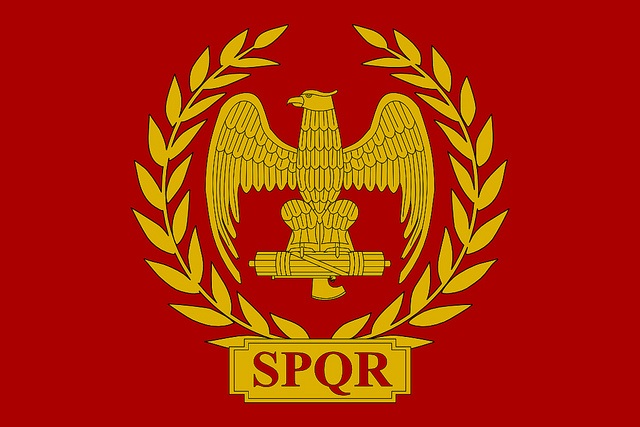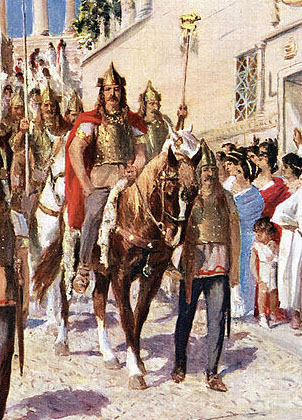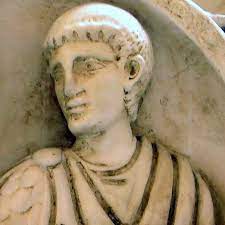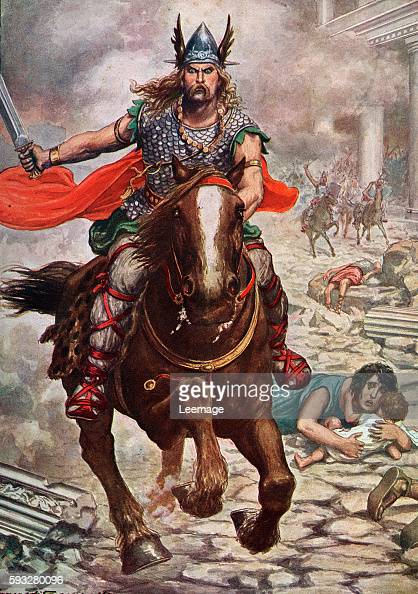End of an Era; Fall of Rome
The Imperial and Pure Roman Empire at its last breathes

The Roman empire started to shake with the attacks directed by the Barbarians from the beginning of the 1st century. Goths, Huns, Visigoths, and several other German barbarians were powerful, and strong under the leadership of their races. Those destructive and blood-hungry barbarians were difficult to catch. They came like the wind, attacked, and disappeared like the darkness at dawn. During the 3rd century, the rising Sassanid empire gifted some terrible defeats to the Roman land armies. Also, with the increasing influence of the Barbarians, many non-roman people and barbarians started to get into the Roman kingdom in uncontrolled amounts.
Splitting of the Imperial Roman Empire
Due to the largeness of the Roman empire, it was really hard for the emperor to handle the Armies were established far east and in the Roman borders. The difficulties faced during the communications, the hesitation of the Roman commanders to obey indirect orders with the rising power, and threats of the Barbarians pulled Roman Empire in the danger more and more. Due to all these facts including the plague of Cyprian, the Roman Empire split into three; The Gallic Empire in the West (260-274), The Palmyrene Empire in the East (260-273), and The Central Roman Empire. In 274, Aurelian reunited the empire. When Diocletian came to power as the successor of Aurelian in 284, he had an imperial Roman Army as in the golden ages of Rome with about four hundred thousand men and forty-five thousand fleets. But during his reign he came up with maintaining, controlling, and ordering the Empire and its Army. So, he solved the problem by creating an adoptive succession with a Senior emperor and a Junior emperor which was called "Augustus" and "Caesar". The Roman empire was divided into two; the Western Roman Empire with the capital at Ravenna and the Eastern Roman Empire with the capital of Byzantium (later became Constantinople). The Eastern Roman Empire existed for a further thousand years more until it finally collapsed during the Crusade Wars in 1453.
The Western Roman Empire and The Eastern Roman Empire work cooperatively for some time. But later the corporation vanished. Eastern residents also had no feeling about The Roman city it was just a symbol for them about the origins of their empire. The Western Roman Empire dealt with civil wars from its beginning. But the Theodosius who controlled both the empires came up with the two civil wars successfully. But after his death, the Western Roman Empire started its break down.
The Western Roman Empire: on the way to the end
During this era, while the Western Roman Empire was struggling for their survival without a patriotic leader, Goths and Huns were rising strongly under their new kings; Attila for the Huns and Alaric for the Goths. Those well-organized barbarian forces started to attack the Western Roman Empire to acquire Rome.
Influences of Alaric on Rome
Alaric; the most powerful and the warrior of Goths worked with the only intention to siege the mighty city of Rome. In 407, Allaric reached Rome with his forces where Rome had to place their civilians and slaves in the war field to defend against Allaric.

Alaric's military operations focused on the port of Rome through which Rome's grain supply had to pass. In 408, Alaric sieged Rome for the 1st time. It bought massive destruction to the property and the reputation of Rome. The 1st siege of Rome was ended after Alaric getting a huge payment from the Romans. But Rome lost most of their labor, many of their slaves as Alaric recruited them with the promise of freedom. While all those were in the play, Alaric had to deal with another enemy; Olympius, the war leader of Huns who led Hunnic mercenaries. But in 409, Olympius was beaten to death even by cutting off his ears before the death. Alaric made a puppet Augustus in Rome called "Priscus Attalus". But Alaric couldn't succeed his plans he hoped to do by his puppet emperor. So, he dethroned him a few months later. Day by day the famine became even more frightful. Historians reveal that even cannibalism was there inside the Roman walls. In 410, Alaric took Rome by starvation. It was the 1st time for Rome to be yielded after eight centuries. The Roman Empire lost its origins where the Roman civilization was born many years ago.
“At that time, they say that Emperor Honorius in Ravenna received the message from one of the eunuchs, evidently a keeper of the poultry, that Roma had perished. And he cried out and said, "And yet it has just eaten from my hands!" For he had a very large cockerel, Roma by name; and the eunuch comprehending his words said that it was the city of Roma which had perished at the hands of Alaric, and the emperor with a sigh of relief answered quickly: "But I thought that my fowl Roma had perished." So great, they say, was the folly with which this emperor was possessed.”
— Procopius, The Vandalic War (De Bellis III.2.25–26)
After the conquer of Rome Alaric moved south intending to sail to Africa. But his ships were wrecked in a storm. Shortly after this Alaric died of fever. After his death, his successor Ataulf came to power and managed the kingdom made by Alaric. He moved to the North into the The turmoil of Gaul. His supergroup of barbarians is called the "Visigoths" now. There, they started developing their sense of identity.
Destiny of the Western Roman empire
From 405-418, the western Roman empire lost its lands more. In 410, civilians in Britannia rebelled against the Roman emperor and got their freedom. Also, Rome lost parts of Hispania and Gaul.
In 421, Constantine Augustus died. He had no successor as his children were not mature enough to rule the empire. After several years, patrician Castinus installed Joannes as the Western Emperor. But the Eastern Roman government asked for child Valentinian III to be the emperor and until his maturation his mother Galla Placidia to be acted as regent. Joannes had a small troop and he sent Aetius to seek help from Huns. While Aetius was out, an Eastern army arrived and excluded Joannes and most of his officials. Three days later Aetius returned to Italy with Hunnic army which made him the most powerful General in Italy. After some fighting Placidia and Aetius had an agreement. The hunnic army was paid and sent back then while Aetius received the position “Magister Militum”, similar to the rank of the Field Marshall at present. Galla Placidia became the Augusta; the female emperor of the Western Roman Empire and was the guardian of the official emperor, her son until 437.
Flavius Aetius: the last true Roman General.

Aetius’s childhood and youth were spent as a hostage of Alaric of Visigoths and later with Huns. So, he could command and deal with those barbarian forces and even had the trust of them with him. After becoming the Magister Militum he was a leading and dominant character in the Western Roman Empire.
In 435, he was given the title of patrician and then continuously fought for the Western Empire. In 435-437, he massacred and destroyed the Burgundian kingdom at Worms.
Meanwhile, Huns were united under the leadership of Attila. Attila became the most powerful leader at the time. He fought to conquer Rome. Under his leadership, the Huns were very powerful and Hunnic forces conquered many lands around and were owned by the Western Roman empire.

In 451, Aetius joined with Visigoths fought with Attila in the Battle of the Catalaunian Plains. It was just not sure as a victory or a defeat. Both the parties were confused with the situations and within the dusk and the darkness. Anyway, Attila gave up fighting at the end and went back. But later Attila invaded Italy and started marching towards Rome. Aetius could do just a little and was failed to stop Attila's marching. But Eastern Roman Forces attacked Attila's noncombat population in Pannonia and Pope Leo's plea for peace stopped Attila's attack on Italy. In 453, Attila died and his great kingdom split and crumbled.
A year later on September 21, 454, at the height of the success, Aetius was stabbed to death by the Western Roman Emperor, Valentinian III.
Attila the Hun
End of an Era; end of the Western Roman Empire and the Fall of Rome
With the death of Aetius, the last straw for Rome to survive vanished. Shortly after the death of Aetius, emperor Valentinian III was killed by his bodyguard.
Avitus, Ricimer, and Majorian came to the power in Italy over time. But they all failed to heal the Roman Empire and to make it on its foot. During their times also barbarian forces invade Roman conquered areas pushing Rome into trouble more and more. Eastern Roman Empire sent Anthemius for the throne of the Western Roman Empire, who was a talented General. But finally, he had trouble with Ricimer and was assassinated. Shortly after Ricimer also died.
After his death, the true patriotic leaders were over. Thereafter Western Roman Empire, which was smaller than at the time of the origin of its empire, was ruled by puppet empires elected played by Warlords.
With the end of 476, Western Roman empires were disappearing. It was scattered and no more Roman Empire existed as at its Origins. Dying empire made an organized legitimate called "Rump state" which was ruled under the Roman rule for a while after 476. Other than that, several new kingdoms arose within Italy. But the Western Roman Senate, which was powerless but influential existed in Rome under the rule of the Ostrogothic kingdom and later under the Byzantine Empire for a least another century. It was disappeared in the early 7th century finishing the final inherent of the Original Roman Empire.